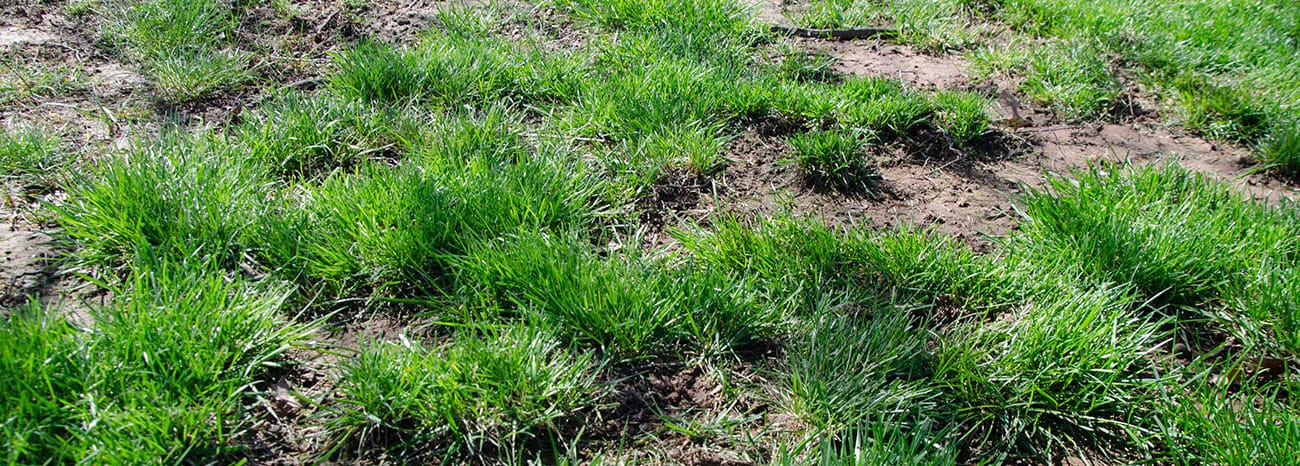Oversleeping. Overeating. Overbooking. Anytime a word starts with “over” it’s not usually about something good. But that’s not true with overseeding. In lawn care, overseeding is the key to returning your lawn to a lush, healthy carpet of green.
I’ve heard of reseeding a lawn. What is overseeding?
Lawn overseeding is a technique used to rejuvenate an existing lawn. Grass gets old over time and needs to be replaced. Lawns can develop thin areas and bare spots, even patches of dead grass. A well-loved lawn will suffer damage from excessive foot traffic from pets and all those family cookouts. Then there’s the weather – some lawns get too much rain, some too little. The same is true for sunlight. These extremes affect surface grasses and soil temperatures.
If you’re thinking about your grass and nodding your head right now, it’s probably time to overseed your lawn.
Overseeding is the process where you aerate your lawn and then spread grass seed over the entire surface. As the new grass grows to fill in bare spots in your lawn, you’ll notice less weeds. This is because as the new healthy growth takes over, it’s harder for the weeds and clover to make their way through the existing lawn.
Another benefit of overseeding your lawn is the introduction of improved turf types that can withstand the barriers to a healthy lawn.
Cool season grasses like perennial ryegrass, annual ryegrass, Kentucky bluegrass and tall fescue are more likely to require overseeding than warm season grasses like Bermuda grass, St. Augustine grass or Buffalo grass.
The good news is that overseeding your existing grass is a more efficient and less expensive process than reseeding.
What time of year should you overseed your lawn?
The best time to overseed your lawn in the northeastern United States is in the fall, ideally anytime mid-August through mid-September. At this time of year there is still enough warmth during the day and cooling at night to encourage seed germination and new growth.
If you can’t get around to overseeding your lawn in the fall, the next best time is in the spring when similar conditions are present.
How to overseed your lawn
Overseeding your lawn is a process that can easily be taken on as a weekend project.
Before you start, make sure you have the right tools and supplies:
- Measuring Wheel
- Rake
- Core Aerator
- Broadcast Spreader
- Topsoil
- Grass Seeds
- Lawn Fertilizer
You’ll also want to choose a day when the weather is calm and not too windy.
Step 1: Measure the area to be overseeded
This will help you buy the right amount of fertilizer and grass seeds. Determine the square footage of your lawn by multiplying the general width and length. A measuring wheel helps to simplify the process.
Step 2: Stop Fertilization
If you are currently fertilizing your lawn, stop. You don’t want to feed the grass and other growth because that will put your new seeds at a disadvantage. Wait for about one month after your last fertilization application to start overseeding.
Step 3: Select the Grass
Decide which type of grass you want to grow.
If you live in the northeastern United States, choose one of the cool season grasses: perennial ryegrass, annual ryegrass, Kentucky bluegrass or tall fescue.
For lawns in the southern United States or a similar climate, choose from the warm season grasses: Bermuda, St. Augustine, Zoysia, Centipede or Buffalo grass.
Step 4: Mow, Clear and Prep
- Mow your lawn on the lowest setting so the grass is ideally no more than 1-1-½” high.
- Rake and remove your grass clippings and if needed, dethatch the lawn to remove any remaining layers of dead grass and other growth.
- Fill in any bare spots with topsoil to encourage new seed growth.
Step 5: Aerate
Using a core aerator or aeration attachment on your riding lawn mower, aerate your lawn to create additional space for the seeds to settle, germinate and grow.
Step 6: Overseed and Fertilize
Using your broadcast spreader, spread the grass seed on your entire lawn. Follow this up with another pass with your broadcast spreader, this time with a starter fertilizer.
Step 7: Water
Lightly water your lawn after this first application, following up with regular watering. You don’t want to over soak the area, water it just enough to give the seeds the moisture needed to germinate and grow.
Maintenance
For the first few weeks after overseeding, you will need to water the area three or four times a day. You can cut back to watering the area once a day as soon as the new grass is one inch high.
Begin regular mowing when the new grass is past two inches in height, keeping it cut to the two-inch level.
Fertilize the lawn six weeks after the overseeding and then repeat on a six-week schedule.
Do you need to overseed your lawn every year?
Overseeding your lawn should be part of your regular lawn maintenance routine. The frequency depends on the overall condition of your lawn and your local climate. Some lawns require overseeding every year and others only every several years. Now that you know what to look for, you’ll be able to tell when your lawn needs overseeding.
Let Us Do the Work So You Can Enjoy the View
Can you handle overseeding your lawn on your own? Of course you can. It’s an investment for sure, you need to buy the equipment and spend the time. You’ll have the satisfaction of a job well done.
When you entrust your lawn overseeding and maintenance to the Moyer Lawn Care experts, you get all of that time back to do the things you love and you still get to enjoy the view of your lush new lawn.
Contact us today for programs and pricing. We’re glad to be of service.


